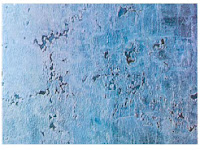(WHITE RUST/WHITE STAIN)
Wet storage stain, also known as white rust, is the voluminous white or gray deposit formed by accelerated corrosion of the zinc coating when closely-packed, newly-galvanized articles are stored or shipped under damp and poorly ventilated conditions.
It is found most often on stacked and bundled items, such as galvanized sheets, plates, angles, bars, and pipe. Weathered zinc surfaces which have already formed their normal protective layer of corrosion products are seldom attacked.
Due to their configuration, many products galvanized after fabrication are less susceptible to wet storage staining than plain galvanized wire and sheet. Wet storage stain results from the exposure conditions and is not indicative of inferior or poor quality galvanizing.
The bulky white or gray corrosion product associated with wet storage stain should not be confused with the protective layer of zinc corrosion products which form under normal atmospheric exposure of galvanized coatings. Even though the corrosion products on fully exposed galvanized surfaces may be white or light gray, they are not the product of wet storage stain.
Their color is solely a function of the environment and the zinc-iron alloy content of the galvanized coating. When wet storage staining is found on galvanized materials, it is not usually in sufficient quantity to be detrimental to coating protection. Normally it disappears with weathering. However, with ill advised transportation, handling and storage methods, it can become serious.
While the galvanizer has a responsibility to produce a galvanized coating of good quality in conformance with governing specifications, the galvanizer is no longer in control after the work leaves the plant. The purchaser must ensure the proper handling and storage of material at the construction site to ensure a stain-free product at the time of final installation.
NORMAL GALVANIZED COATING CHEMISTRY
Before considering how wet storage stain occurs on a galvanized part, it is important to understand how freshly coated zinc surfaces interact with the atmosphere. Once the basics of the zinc-atmosphere interactions are understood, the formation and prevention of wet storage stain can be explained.
Since zinc is very reactive, any zinc surface in contact with the surrounding air will quickly form a layer of zinc oxide. The formation of this thin, hard, layer is the first step in the development of the protective corrosion product film normally associated with galvanized coatings.
When this surface has access to freely moving airin normal atmospheric exposure, it reacts with rainfall or dew to form a porous, gelatinous zinc hydroxide corrosion product. During drying, this product reacts with carbon dioxide in the atmosphere and converts into a thin, compact and tightly adherent layer of corrosion products consisting mainly of basic zinc carbonate generally written as 2ZnCO3·3Zn(OH)2.
The long life normally associated with galvanized coatings in atmospheric service is entirely dependent upon the protection of the basic zinc carbonate. Being relatively insoluble, the basic zinc carbonate layer is weather-resistant and, once formed, minimizes further corrosion. After a period of time, this whitish-gray powdery film tends to mask the underlying zinc crystals on the surface of the galvanized coating.
The degree of protection obtained in a given case varies with the nature of the environment. The presence of chlorides and sulfur gases in the air, for example, modify the composition of the carbonate layer and tend to increase its solubility allowing rain and moisture to dissolve the carbonate layer more rapidly. Thus the life of a galvanized coating is generally shorter in marine
and industrial atmospheres than it is in the cleaner air of a rural environment. On a galvanized part, the basic chemical conversion on the surface of zinc metal to zinc carbonate is the mechanism that is interrupted by the formation of wet storage stain.
WET STORAGE STAIN CHEMISTRY
When galvanized articles are closely packed, deprived of freely moving air and exposed to moisture, an entirely different set of conditions arises in the chain of zinc chemical changes. Without the free flow of carbon dioxide over the galvanized surface, the surface retains water and forms an “oxygen concentration cell.”
The effect may be best explained in terms of the reactions which occur under a drop of water flattened between two surfaces. The resultant water film obviously has only a minimal surface exposed to air; meaning that the zinc surface near the middle of the water drop or film gets a different supply of oxygen than does the zinc surface at the periphery of the water drop. This difference in turn sets up a difference in the electrolytic potential of the zinc. The central area becomes anodic and the edge area becomes cathodic, thus creating theOxygen concentration cell (Figure 1).
The attack on the zinc occurs at the anodic area. The corrosion products are modifications of the nonprotective relatively soluble zinc hydroxide. Since this hydroxide remains rather stable under these conditions, zinc ions constantly leave the coating to be bound by water, thus accelerating corrosion. The limitation of access to oxygen is also a limitation of access to carbon
dioxide and this hinders conversion of zinc hydroxide to the protective zinc carbonate. The corrosion products in this case are not protective and corrosion proceeds as long as the original conditions prevail. The moisture necessary for the formation of wet storage stain may originate in various ways. It may be present on the galvanized parts at the time of stacking or packing, as a result of incomplete drying after quenching. It may also be a result of direct exposure to rain or sea water, or from condensation caused by atmospheric temperature changes. Close packing can result in moisture being retained by capillary action between the surfaces in contact because drying is delayed by the lack of circulating air.
The extent of the damage by wet storage stain depends on the duration of exposure to retained moisture and the environment. The attack is accelerated when the retained moisture contains chlorides from sea water, sulfur compounds from industrial environments, or flux residues from the galvanizing operations. Each of these contaminants heightens the oxygen concentration cell’s effect by increasing the water’s electrical conductivity. The important thing to realize, however, is that severe damage can be done in a relatively short time by water alone, without any other contributing factors. Because the corrosion products of wet storage stain are voluminous, any attack may appear more serious than it actually is. The volume change from zincmetal
to zinc-oxide or zinc-hydroxide is 3 to 5 times greater. Medium or even heavy layers of wet storage stain are very unsightly, but they represent the loss of very little zinc from the base coating. The thicker zinc coatings provided by after fabrication hot dip galvanizing usually result in wet storage stain having little or no significant effect on the durability and intended service life of the coating.
STORAGE AND TRANSPORTATION
Whenever galvanized articles are packed closely together for appreciable periods of time, adequate precautions should be taken against wet storage stain. Wet storage stain can be minimized by maintaining a low humidity environment around the material and by providing
adequate ventilation between the stacked pieces. Points to be observed are:
1. The galvanized ste

el, as produced, should be clean and free from flux residues.
2. The material should be stored under cover in dry, well ventilated conditions, with heating
facilities. It is very important to store the materials away from open doorways.
3. If outdoor stacking is unavoidable, the articles should be raised from the ground and
separated with strip spacers to provide free access of air to all parts of the surface. They also should be inclined in a manner which will give maximum drainage. Do not store galvanized steel on wet soil or decaying vegetation.
The use of spacers is also recommended during any shipping if there is the likelihood of condensation. For example, where material is chilled in traveling over mountains and then exposed to warmer and more humid air at lower levels, spacers are mandated. It is important that resinous wood not be used for spacers or packing, since the resin itself can start corrosion. Woods recommended for use in transporting and storing galvanized products should be dry and untreated with preservatives or fire retardant chemicals. Poplar, ash and spruce have been
used quite satisfactorily in contact with galvanized steel in storage and transport.
4. Small items that are quenched and stored in containers should be thoroughly dried before
packing. When the containers are sealed, the inclusion of a

desiccant is recommended.
5. Uncovered material should not be left standing at in-transit loading points where it may be
exposed to rain, mist, condensation, or snow.
6. When shipping overseas, galvanized steel should not be consigned as deck cargo or stowed in
parts of the ship’s hold where contact with bilge water is likely. As noted before, sea water is especially corrosive under conditions conducive to wet storage stain. The high humidity at sea, particularly in the tropics, makes the provision of dry, well ventilated facilities particularly important.
SURFACE TREATMENTS TO INHIBIT CORROSION
Various surface treatments are available to reduce the possibility of wet storage stain. Conduit and hollow ware often are coated with a clear film after galvanizing. Waxes and oils are commonly used on products such as wire, sheet steel and fencing. For after fabrication hot dip galvanizing, chromate dip treatments, or other proprietary solutions, are sometimes utilized.
Most after fabrication hot dip galvanized products are shipped without any post treatment.
The need for a surface treatment largely depends on the configuration of the product and the anticipated storage conditions. Galvanized items which are tightly stacked or nested are particularly vulnerable to wet storage stain, especially if they are stored as unopened bundles for more than a few weeks. On the other hand, fabricated assemblies, which fully expose the galvanized surfaces, typically do not need a post treatment. If the galvanized surface will be painted within six months, a post treatment may interfere with paint adhesion. Communicating with the galvanizer will establish how to prepare the surface for painting.
REMEDIAL ACTIONS
Wet storage staining of galvanized coatings is often superficial, despite the presence of a bulky
corrosion product. In the vast majority of cases, wet storage stain does not indicate serious degradation of the zinc coating, nor does it necessarily imply any likely reduction in the expected life of the product.
When wet storage stain has occurred, the objects should be arranged so that their surfaces dry rapidly. Once dry, the articles should be examined. Where the surface staining is light and smooth, as seen on the guardrail in Figure 8, or as judged by lightly rubbing the fingertips across the surface, the stain will disappear gradually and blend with the surrounding zinc surface as a result of normal weathering in service. When the affected area will not be fully exposed in service, or when it will be subject to a humid environment, wet storage stain should be removed, even if it is superficial. This allows for the formation of the protective zinc carbonate
film.
Medium to heavy build-up of white corrosion products, as shown on the structural tubing in
Figures 6 and 7, must be removed, otherwise the essential protective film of basic zinc carbonates cannot form in affected areas. Deposits can be removed by brushing with a stiff bristle (not wire) brush.
A coating thickness check should be performed on the affected areas to ensure that sufficient zinc coating remains after the removal of the wet storage stain. In advanced stages of wet storage stain, the typical white or gray corrosion product may become black in color. When this occurs, a significant amount of coating has been lost to corrosion and the service life is decreased.
In extreme cases where heavy white deposit or red rust has formed as a result of prolonged storage under poor conditions, as shown on the large tubes in Figure 5, corrosion products must be removed and the damaged area repaired as detailed in ASTM A780 Standard Practice for Repair of Damaged and Uncoated Areas of Hot-Dip Galvanized Coatings. Where the affected area is extensive, or when the wet storage stain would impair the use of the article for its intended service, regalvanizing may be necessary.






 :.
:.

 :.
:.






























